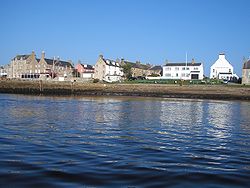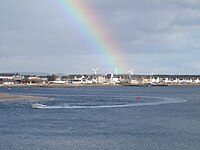Difference between revisions of "Findhorn"
(Created page with "{{Infobox town |name=Findhorn |gaelic=Inbhir Èireann |county=Morayshire |picture=Findhorn.jpg |picture caption=The Loading Bank at Findhorn |os grid ref=NJ038644 |latitude=57...") |
m (→Name=: rm extra code) |
||
| Line 22: | Line 22: | ||
The Findhorn Foundation, an educational charity and [[Findhorn Ecovillage]] are located to the south of the village. | The Findhorn Foundation, an educational charity and [[Findhorn Ecovillage]] are located to the south of the village. | ||
| − | ==Name | + | ==Name== |
| − | Although surely Gaelic in origin as are most of the village names on this coast, the derivation of the name "Findhorn" is not absolutely clear. | + | Although surely Gaelic in origin, as are most of the village names on this coast, the derivation of the name "Findhorn" is not absolutely clear. |
The name may be a corruption of ''Invererne'', meaning 'Mouth of the river Erne'. It may be from ''Fionn-Dearn''; "the white river Dearn", or perhaps ''Fionn'' simply referring to the white sands and breaking waves which dominate the shores.There is also the possibility that Findhorn is Gaelic ''Fionn-dearna'' or white palm of hand or ''Fionn-dorn'' which means white fist and white handle (usually hilt of a sword or dagger). | The name may be a corruption of ''Invererne'', meaning 'Mouth of the river Erne'. It may be from ''Fionn-Dearn''; "the white river Dearn", or perhaps ''Fionn'' simply referring to the white sands and breaking waves which dominate the shores.There is also the possibility that Findhorn is Gaelic ''Fionn-dearna'' or white palm of hand or ''Fionn-dorn'' which means white fist and white handle (usually hilt of a sword or dagger). | ||
Latest revision as of 13:04, 12 October 2023
| Findhorn Gaelic: Inbhir Èireann | |
| Morayshire | |
|---|---|
 The Loading Bank at Findhorn | |
| Location | |
| Grid reference: | NJ038644 |
| Location: | 57°39’36"N, 3°36’50"W |
| Data | |
| Postcode: | IV36 |
| Local Government | |
| Council: | Moray |
Findhorn is a village in Morayshire, on the east side of the mouth od the River Findhorn as it enters Findhorn Bay on the Moray Firth.
Findhorn is 3 miles northwest of Kinloss, and about 5 miles by road from Forres.
The Findhorn Foundation, an educational charity and Findhorn Ecovillage are located to the south of the village.
Contents
Name
Although surely Gaelic in origin, as are most of the village names on this coast, the derivation of the name "Findhorn" is not absolutely clear.
The name may be a corruption of Invererne, meaning 'Mouth of the river Erne'. It may be from Fionn-Dearn; "the white river Dearn", or perhaps Fionn simply referring to the white sands and breaking waves which dominate the shores.There is also the possibility that Findhorn is Gaelic Fionn-dearna or white palm of hand or Fionn-dorn which means white fist and white handle (usually hilt of a sword or dagger).
History
Original settlement
The existing settlement is the second village to bear this name, the original having been a mile to the northwest of the present position and inundated by the sea. This transposition was not an overnight catastrophe but a gradual withdrawal from the earlier site during the late seventeenth and early eighteenth centuries. Some sources[1] claim that the village of today is the third village to bear the name, perhaps assuming that the seventeenth century destruction of the nearby Barony of Culbin by shifting sands resulted in an earlier relocation.
Major seaport
In the seventeenth century Findhorn was the principal seaport of Moray and vessels regularly sailed to and from all parts of the North Sea and as far as the Baltic ports. Changes to the narrow and shallow entrance to the Bay created obstacles to navigation and as the size of trading vessels increased so the volume of trade to the village declined.
Findhorn Bay witnessed a brief episode in the 1745 Jacobite Rebellion. In March 1746 the French brigantine Le Bien Trouvé entered the tidal waters with dispatches for Bonnie Prince Charlie but her departure, with the Prince’s aide-de-camp on board, was delayed by the arrival of two British men-o’-war. Unable to enter the shallow bay, the two warships lay in wait in the Firth. Somehow Le Bien Trouvé slipped out and away to safety on a dark night. The name is recalled in the modern-day training gig of the same name which is based at Findhorn.
Fishing village
During the nineteenth century fishing predominated. During the 1829 floods known as "The Muckle Spate" five Findhorn fishing boats rescued Forres residents. For a few years (1860-9) there was a branch railway line to the village to take advantage of the herring fleet.
Modern times
The early twentieth century saw a decline in fishing as the traditional two-masted zulus were in their turn being replaced by larger vessels. Some of the craft, 'temporarily' beached on the western shore of the Bay whilst their crews fought in the First World War, were never used again. The wreckage is still visible at low tide. The shore-based salmon fisheries lasted until the 1980s but they too are no more. Today the village is a dormitory suburb and leisure craft dominate the moorings.
The Crown and Anchor Inn, dating from 1739, is the oldest surviving structure in the village. Other prominent buildings of note include Findhorn House built in 1775, which is the home of the Royal Findhorn Yacht Club, The Kimberley Inn, the James Milne Institute, The Universal Hall at the Findhorn Foundation and the ice house Heritage Centre.
Findhorn Golf Club (now defunct) was founded in 1926 and continued until the Second World War.[2]
Outside links
| ("Wikimedia Commons" has material about Findhorn) |
References
- ↑ Graham
- ↑ “Findhorn Golf Club, Moray”, “Golf’s Missing Links”.
- Graham, C. (1977). Portrait of the Moray Firth. London. Robert Hale.
- Cochrane, R.G. & Shand, W. (1981). Findhorn: A Scottish Village. Findhorn Press.
- Lauder, T.D. (1873). An Account of the Great Floods of August 1829. J. McGillivary.
- McKean, Charles (1987). The District of Moray: An Illustrated Architectural Guide. Scottish Academic Press.
- Sellar, W.D.H. (editor) (1993). Moray: Province and People. Scottish Society for Northern Studies.
- Ross, Sinclair (1992). The Culbin Sands: Fact and Fiction. University of Aberdeen
